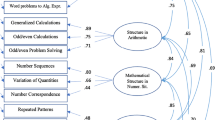Abstract
Several researchers suggest that students' difficulties with the algebraic structure are in part due to their lack of understanding of structural notions in arithmetic. They assume that the algebraic system used by students inherits structural properties associated with the number system with which students are familiar. This study explored this assumption. In an attempt to discover whether wrong interpretations of the algebraic structure found in an algebraic context occur in a purely numerical one, we interviewed 53 sixth-graders individually. The assessment confirms the assumption: students' difficulties with the algebraic structure were found in purely numerical contexts. However, the study also confirms two, seemingly, contradictory observations. On the one hand, the students' interpretations of the structures of the expressions were very consistent; that is, the same tendencies were found in many students' answers. In this sense the students' behaviour was consistent. On the other hand, it was clearly observed that the same student may give an incorrect answer in one context and a correct answer in another. In this sense, it often seemed that the students were inconsistent.
Similar content being viewed by others
References
Bell, A., Swan, M. and Taylor, G.: 1981, ‘Choice of operation in verbal problems with decimal numbers’, Educational Studies in Mathematics 12, 399–420.
Booth, L. R.: 1981, ‘Strategies and errors in generalized arithmetic’, in C. Comiti and G. Vergnaud (eds.), Proceedings of the Fifth International Conference of the International Group for the Psychology of Mathematics Education, France pp. 140–146.
Booth, L. R.: 1984, Algebra: Children's Strategies and Errors. Windsor, UK: NFER-Nelson.
Booth, L. R.: 1988, ‘Children's difficulties in beginning algebra’, in A. F. Coxford (ed.), The Ideas of Algebra. K-12. Reston, VA: National Council of Teachers of Mathematics, pp. 20–32.
Cortes, A., Vergnaud, G. and Kavafian, N.: 1990, ‘From arithmetic to algebra: Negotiating a jump in the learning process’, in G. Booker, P. Cobb and T. N. Mendicuti (eds.), Proceedings of the Fourteenth International Conference of the International Group for the Psychology of Mathematics Education, Mexico City, Mexico, 2, pp. 27–34.
Erlwanger, S. H.: 1973, ‘Benny's conception of rules and answers in IPI mathematics’, Journal of Children's Mathematical Behavior, 1,2 Autumn.
Erlwanger, S. H.: 1975, ‘Mat's conception of methods and answers in mathematics’, Journal of Children's Mathematical Behavior, 1,3 Summer.
Filloy, E. and Rojano, T.: 1984, ‘From an arithmetical to an algebraic thought’, in J. M. Moser (ed.), Proceeding of the Sixth Annual Meeting of PME-NA, 51–56, Madison, Wisconsin.
Filloy, E. and Rojano, T.: 1989, ‘Solving equations: The transition from arithmetic to algebra’. For the Learning of Mathematics 9(2), 36–59.
Fischbein, E., Deri, M., Nello, M. S. and Marine, M. S.: 1985, ‘The role of implicit models in solving verbal problems in multiplication and division’, Journal for Research in Mathematics Education 16(1), 3–17.
Ginsburg, H.: 1977, Children's Arithmetic: The Learning Process. Van Nostrand, New York.
Greeno, J. G.: 1982, A Cognitive Learning Analysis of Algebra. Paper presented at the AERA, Boston, MA.
Herscovics, N. and Linchevski, L.: 1994, ‘A cognitive gap between arithmetic and algebra’, Educational Studies in Mathematics 27(1), 59–78.
Kieran, C.: 1984, ‘Cognitive mechanisms underlying the equation-solving errors of algebra novices’, in Southwell et al. (eds.), Proceedings of PME-VIII, Sydney, Australia, pp. 70–77.
Kieran, C.: 1988, ‘Two different approaches among algebra learners’, in A. F. Coxford (ed.), The Ideas of Algebra. K-12, National Council of Teachers of Mathematics, Reston, VA; Lawence Erlbaum, Hillsdale, NJ, pp. 91–96.
Kieran, C.: 1989, ‘The early learning of algebra: A structural perspective’, in S. Wanger and C. Kiearn (eds.), Research Issues in the Learning and Teaching of Algebra, National Council of Teachers of Mathematics; Reston, VA: Lawence Erlbaum, Hillsdale, NJ, pp. 33–56.
Kieran, C.: 1992, ‘The learning and teaching of algebra’, in D. A. Grouws (ed.), Handbook of Research on Mathematics Teaching and Learning, Macmillan, New York: pp. 390–419.
Kieran, C. and Sfard, A.: 1997, ‘Seeing through symbols: The case of equivalent expressions’, Focus on Learning Problems in Mathematics (in press).
Kirshner, D.: 1989, ‘The visual syntax of algebra’, Journal for Research in Mathematics Education 20, 274–287.
Lee, L.: 1996, ‘An initiation into algebraic culture through generalization activities’, in N. Bednarz, C. Kieran and L. Lee (eds.), Approaches to Algebra Perspectives for Research and Teaching, Kluwer Academic Publishers, Dordrecht, pp. 87–107.
Linchevski, L. and Herscovics, N.: 1994, ‘Cognitive obstacles in pre-algebra’, Proceedings of the 18th Conference for the Psychology of Mathematics Education 4, 257–265.
Linchevski, L. and Herscovics, N.: 1996, ‘Crossing the cognitive gap between arithmetic and algebra: Operating on the unknown in the context of equations’, Educational Studies in Mathematics 30(1), 39–65.
Linchevski, L. and Vinner, S.: 1990, ‘Embedded figures and structures of algebraic expressions’, in G. Booker, P. Cobb and T. N. Mendicuti (eds.), Proceedings of the Fourteenth International Conference of the International Group for the Psychology of Mathematics Education, Mexico City, Mexico, 2, pp. 85–93.
Lins, R. L.: 1990, ‘A framework of understanding what algebraic thinking is’, in G. Booker, P. Cobb and T. N. Mendicuti (eds.), Proceedings of the Fourteenth international Conference of the international Group for the Psychology of Mathematics Education, Mexico City, Mexico, 2, pp. 93–101.
Matz, M.: 1980, ‘Building a metaphoric theory of mathematical thought’, Journal of Mathematical Behavior 3(1), 93–166.
Vermeulen, N., Olivier, A. and Human, P.: 1996, ‘Students awareness of the distributive property’, Proceedings of the 20th Conference for the Psychology of Mathematics Education, Valencia, Spain.
Wong, M.P.: 1997, ‘Numbers versus letters in algebraic manipulation: Which is more difficult?’, Proceedings of the 21st Conference for the Psychology of Mathematics Education, Lahti, Finland, 4, pp. 285–290.
Author information
Authors and Affiliations
Rights and permissions
About this article
Cite this article
Linchevski, L., Livneh, D. Structure sense: The relationship between algebraic and numerical contexts. Educational Studies in Mathematics 40, 173–196 (1999). https://doi.org/10.1023/A:1003606308064
Issue Date:
DOI: https://doi.org/10.1023/A:1003606308064




